Franz Sigmund, 1877-1940
by Brian Stevenson
last updated September, 2021
Professor Doctor Franz Sigmund produced high-quality microscope slides, primarily of anatomical / histological specimens, from about 1910 through about 1930. Sigmund supplied his slides in sets of 10, with some 5-10 of those sets comprising a series on a topic such as anatomy of vertebrates or invertebrates, or botanical structures. Each set and series was accompanied by a booklet with illustrations and detailed descriptions of the specimens. The slides were distributed by the Franckh'sche Verlagshandlung of Stuttgart, Germany, who also published the scientific magazine Mikrokosmos. Sigmund later became a regular contributor to Mikrokosmos, and some of his slides include that name on the labels.
Franckh'sche Verlagshandlung and Microkosmos also sold Eduard Thum's microscope slides after 1916, and his preparations from after that year bear labels that resemble those of Sigmund (an illustrated essay on the life and works of Eduard Thum can also be read on this site).
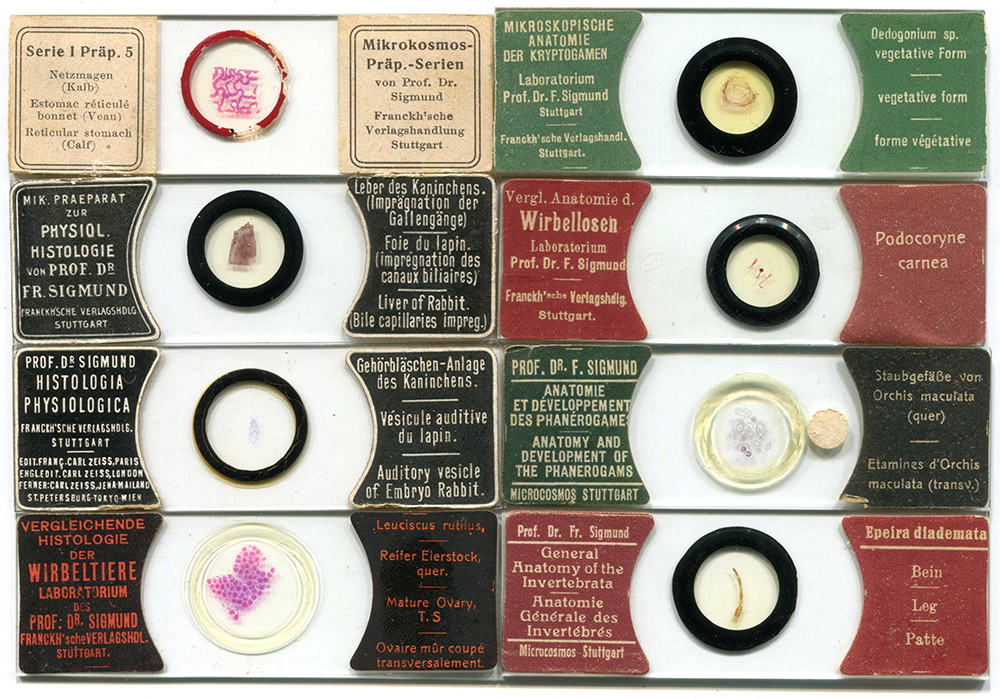
Figure 1.
Examples of microscope slides from Franz Sigmund. He used a variety of different label styles over his 20+ year career. Sigmund produced numerous copies of each series over several years, so surviving slides from the same series might have different label styles. Details were often provided in English and French, as well as German, indicative of Sigmund's very wide distribution range.
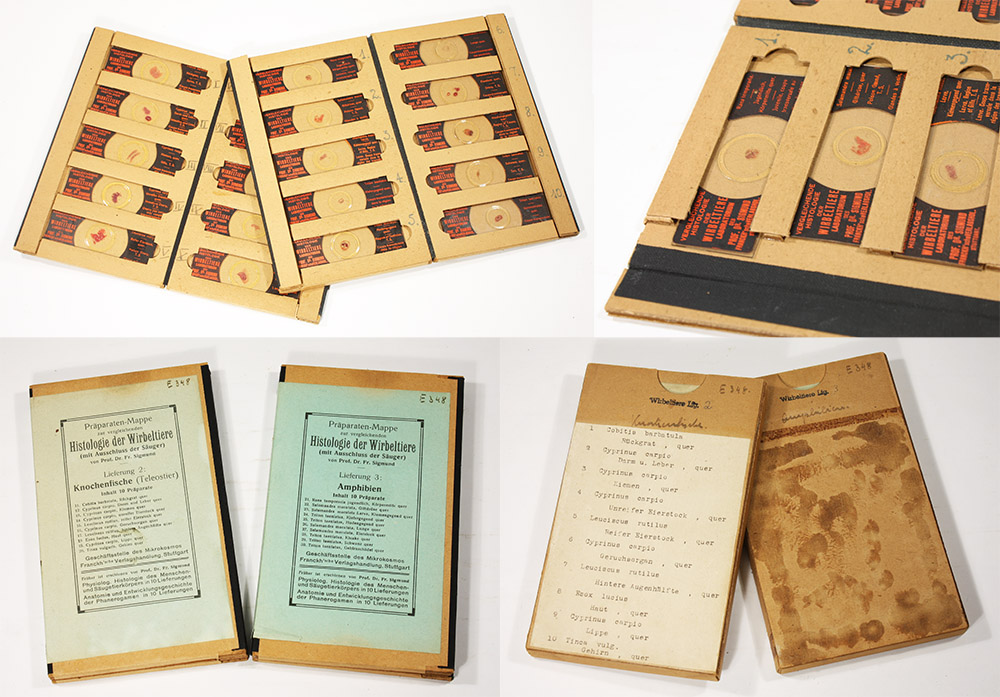
Figure 2.
Two sets of slides from Sigmund's 5-part series on "Histologie der Wirbeltiere" ("Histology of Vertebrates"): bony fish (number 2) and amphibians (number 3). The 10 slides of each set slide into a cardboard holder, which folds to hold them inside, and then slips into a cardboard sleeve.
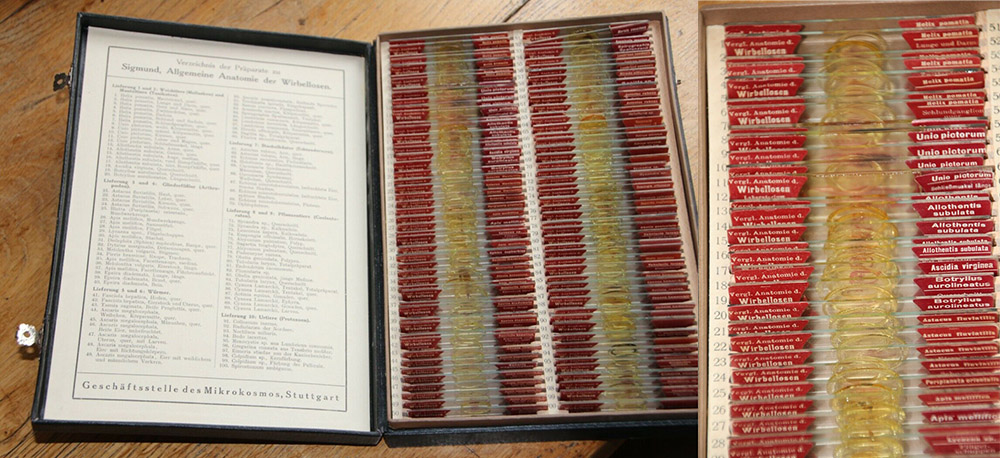
Figure 3.
Sigmund's 10-part series on "Allgemeine Anatomie der Wirbellosen" ("General Anatomy of Invertebrates"), combined in a single slidebox. Adapted for nonprofit, educational purposes from an internet auction site.
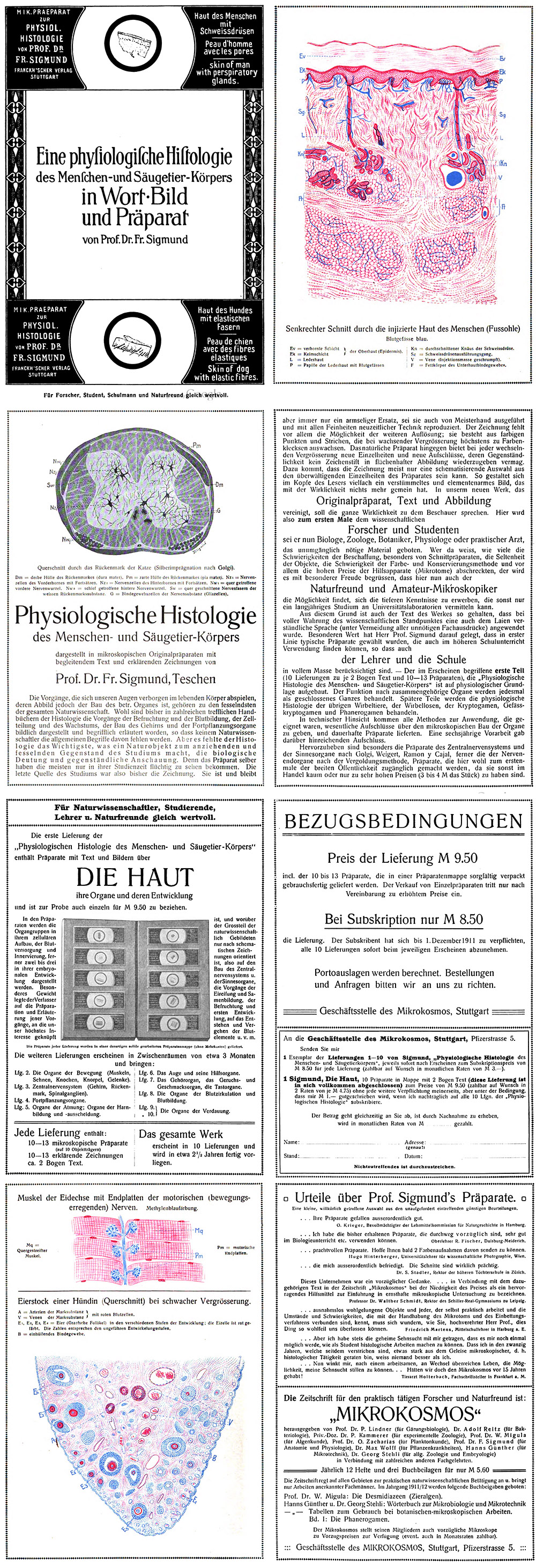
Figure 4.
A 1912 multi-page advertisement for Sigmund's slides, including description of his accompanying booklets. From Heinrich Stridde's "Allgemeine Zoologie", which was published by Franckh'sche Verlagshandlung, who also distributed Sigmund's slides.
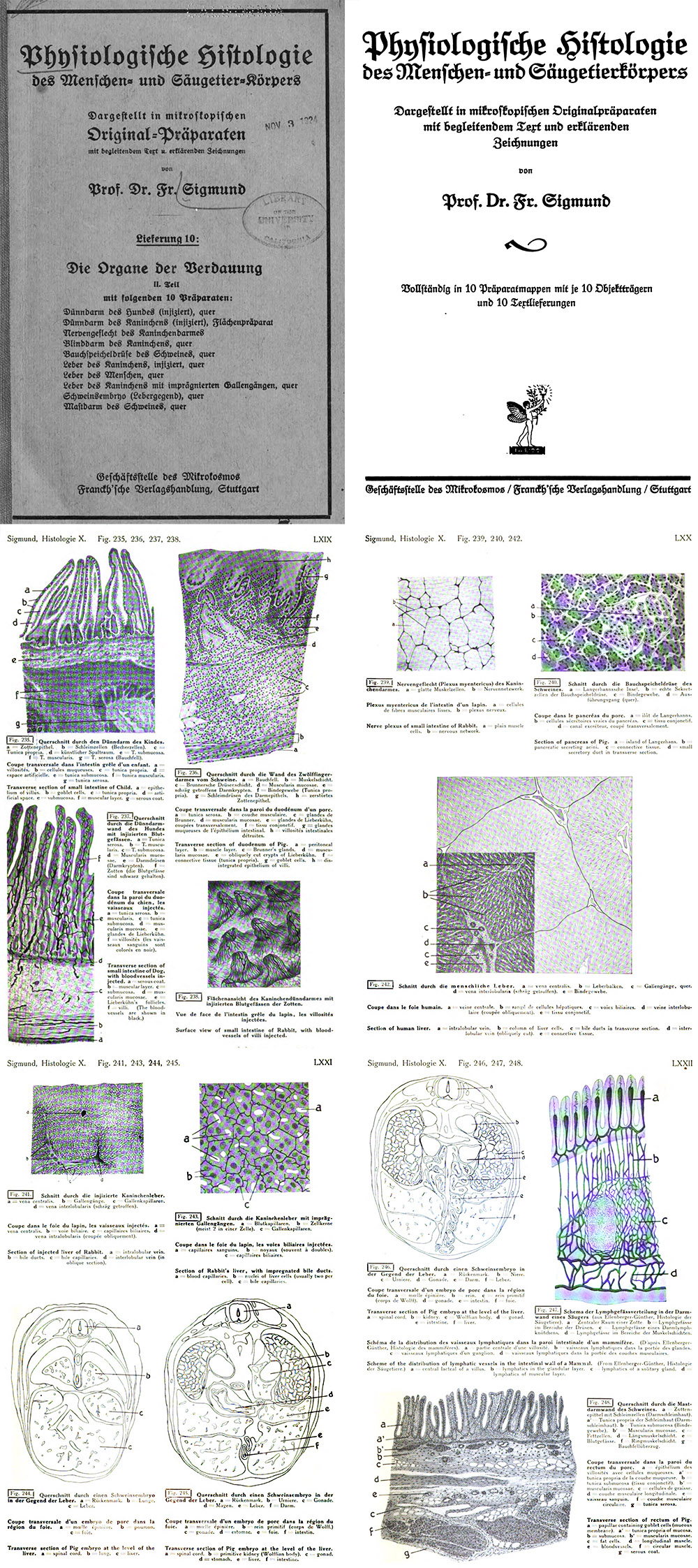
Figure 5.
Cover and excerpts from Sigmund's ca. 1924 booklet on "Physiologiche Histologie des Menschen und Säugetier-Körpers" ("Physiological Histology of Man and Mammalian Bodies"), including descriptions, photomicrographs, and drawings of specimens that were included in the series.
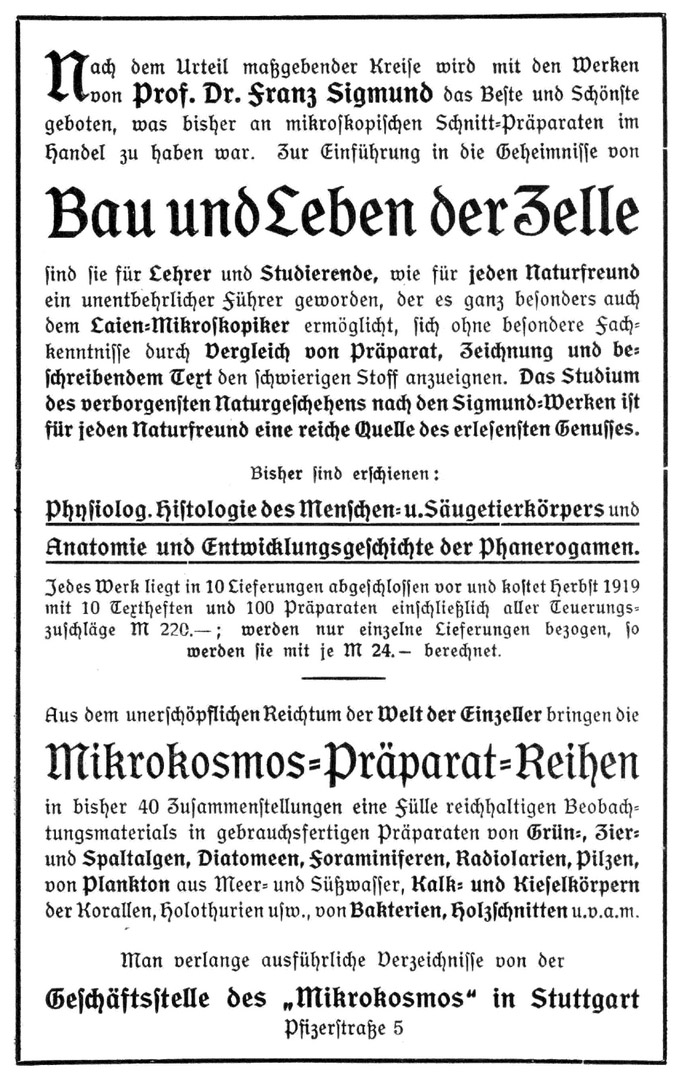
Figure 6.
A 1919 advertisement, from Wilhelm Bölsche's "Eiszeit und Klimawechsel", which was published by Sigmund's distributor.
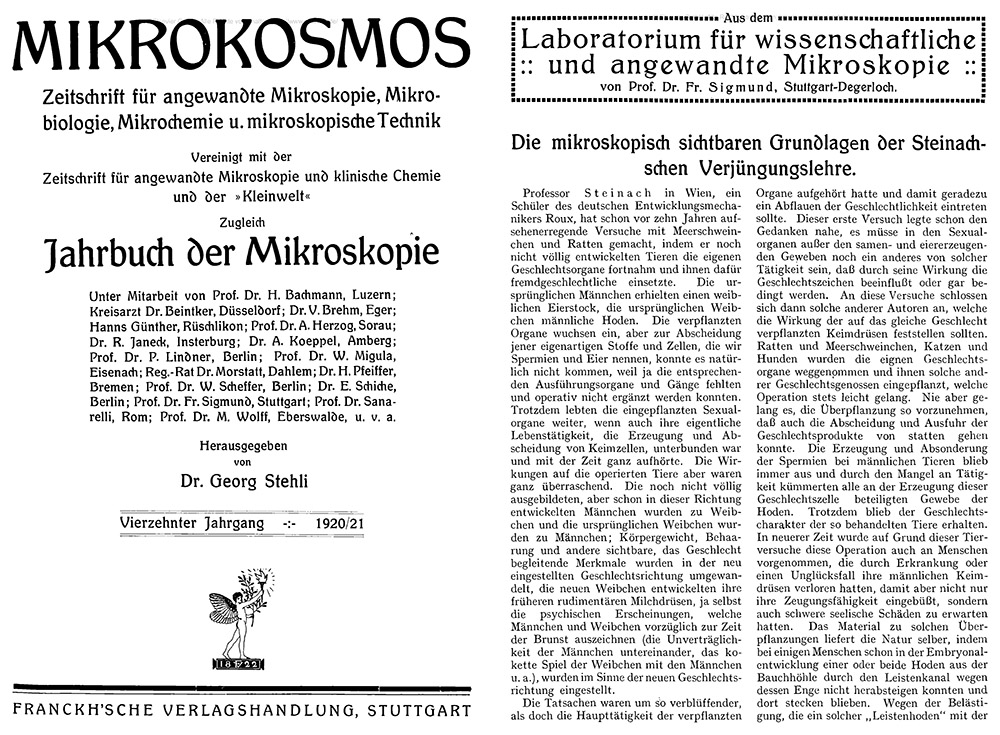
Figure 7.
(Left) Masthead from the 1921/1922 Yearbook of Microscopy from "Mikrokosmos", listing Franz Sigmund among the contributors. (Right) The first page of Sigmund's contribution, which includes states that he had established his "Laboratorium für Wissenschaftliche und Angewandte Mikroskopie" in the Degerloch area of Stuttgart.
I have not found any information on Franz Sigmund's early life. The earliest record yet located is a 1903 announcement that "Dr. Franz Sigmund" was appointed teacher at the Albrechts-Gymnasium in Teschen (now Cieszyn, Poland). He was later described as "Dr. phil." (i.e. Ph.D.), and his fields of expertise imply training in biological and chemical sciences. Sigmund was awarded the title of "Professor" in 1906. He taught various sciences, as evidenced by articles that he published on teaching chemistry and mineralogy as a combined subject, and on how to handle questions on sex during biology classes.
Sigmund appears to have begun commercial production of slides and booklets around 1910 – a copy of his Mikroskopische Anatomie der Kryptogamen booklet with that date is known. As with all of his later books and slides, it was published by Franckh'sche Verlagshandlung. While the publisher's address of Stuttgart appears on Sigmund's slide labels and booklets, he remained in Teschen until 1920.
Sigmund's business was in full swing by 1912. In that year, he sought a U.S. copyright for "Physiologische histologie des menschen- und säugetierkörpers, dargestellt in mikroskopischen originalpräparaten mit begleitendem text und erklärenden zeichnungen von prof. dr. Fr. Sigmund". Multi-page advertisements for Sigmund's preparations were included in numerous books, including Heinrich Stridde's Allgemeine Zoologie (1912), Julius Donau's Arbeitsmethoden der Mikrochemie (1913), and Adolf Reiz's Apparate und Arbeitsmethoden der Bakteriologie (1914), all of which were also published by Franckh'sche Verlagshandlung.
He moved from Teschen to Stuttgart in 1920, being absent from the 1920 edition of the Stuttgart Directory but present in later editions, and providing his address as "Stuttgart" in the 1920/1921 Yearbook of Microscopy (Figure 7). The Yearbook of Microscopy gave Sigmund's affiliation as "Laboratorium für Wissenschaftliche und Angewandte Mikroskopie" (Laboratory of Scientific and Applied Microscopy). Production of microscope slides appears to have been Sigmund's primary occupation throughout the 1920s (Figure 8).
During the late 1920s, Sigmund developed a different sort of business: manufacturing hair care products (Figures 8-10). In March, 1928, he filed for trademark protections in the USA (Figure 9). His major product appears to have been "Dakrysol", a hair tonic that included ingredients such as cholesterol, and was advertised to be physiologically good for one's hair. Advertisements for Dakrysol have been identified into the mid-1930s.
In late 1934, Sigmund moved to the suburb of Vaihingen. He died there in 1940. His widow continued the hair tonic business, until the laboratory was destroyed during an air raid in 1943.
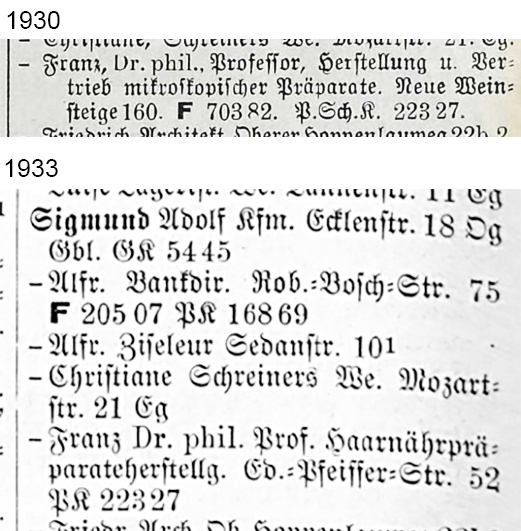
Figure 8.
Excerpts from the 1930 and 1933 "Amtliches Stuttgarter Adressbuchen". In 1930, he described himself as a "producer and distributor of microscopical preparations", while in 1933 he was a "manufacturer of hair care products". He also moved during that time, from 160 Neue Weinsteige (where he had been since he arrived in Stuttgart) to 52 Eduard Pfeiffer St.

Figure 9.
March, 1928, Franz Sigmund filed U.S. trademark applications for a facimile of his signature and the brand name "Dakrysol", both associated with his new hair care business.
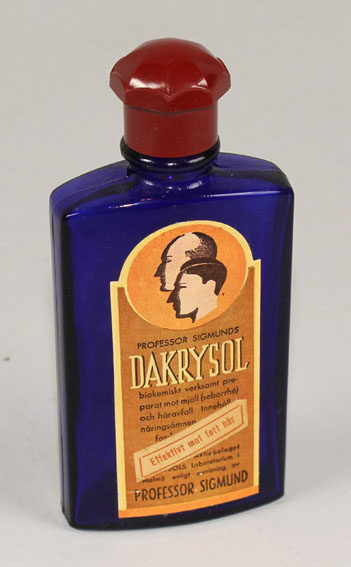
Figure 10.
A bottle of Dakrysol. Adapted for nonprofit, educational purposes from https://www.europeana.eu/en/item/76/jlm_item_54283
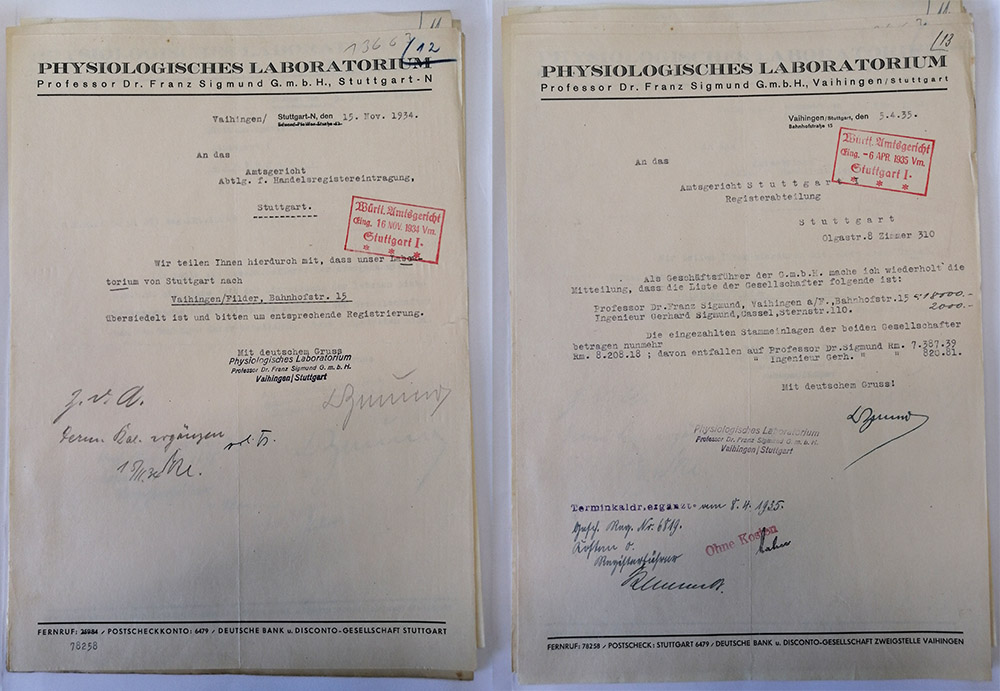
Figure 11.
Letters from Sigmund's Physiologisches Laboratorium, dated November 15, 1934, and April 5, 1935. Note that the address on the November, 1934 letter has been crossed out, and "Vaihingen" has been typed beside it. The 1935 letter includes his new address of Vaihingen in the letterhead. Images courtesy of Dietmar Speidel and the Historical Society of Vaihingen.
Acknowledgements
Thank you to Dietmar Speidel, Thomas Schuetz, and the Historical Society of Vaihingen for generously sharing information on Franz Sigmund's life.
Resources
Amtliches Stuttgarter Adressbuch (1920) Franz Sigmund was not listed
Amtliches Stuttgarter Adressbuch (1922) "Sigmund, Franz, Dr. phil., Professor. Neue Weinsteige 160", page 458
Amtliches Stuttgarter Adressbuch (1930) "Sigmund, Franz, Dr. phil., Professor, Herstellung u. Bertrieb mikroskopischer Präparate. Neue Weinsteige 160", page 571
Amtliches Stuttgarter Adressbuch (1933) "Sigmund, Franz, Dr. phil., Prof., Haarnährpräparateherstellg. Ed. Pfeiffer Str. 52", page 506
Amtliches Stuttgarter Adressbuch (1938) "Sigmund, Franz, Dr. phil. Prof. Ed. Pfeiffer Str. 52", page 563
Bölsche, Wilhelm (1919) Eiszeit und Klimawechsel, Franckh'sche Verlagshandlung, Stuttgart
Bracegirdle, Brian (1998) Microscopical Mounts and Mounters, Quekett Microscopical Club London, pages 83-84 and 170, and Plates 33-C, 33-D, 33-E, and 33-F
Catalog of Copyright Entries: Books (1912) "Sigmund, Franz", Vol. 9, Issue 1, Library of Congress, page 1745
Donau, Julius (1913) Arbeitsmethoden der Mikrochemie, Franckh'sche Verlagshandlung, Stuttgart
Gunther, Hans (1918) Das Mikroskop and seine Nebenapparate, Franckh'sche Verlagshandlung, Stuttgart
Official Gazette of the United States Patent Office (1928) Trademark applications by Franz Sigmund, Vol. 373, pages 14-15
Reiz, Adolf (1914) Apparate und Arbeitsmethoden der Bakteriologie, Franckh'sche Verlagshandlung, Stuttgart
Rosenbauer, Karlheinz A. (2003) Mikroskopische Präparate, J. Wiley & Sons, pages 55-56
Sigmund, Franz (1905) Die Behandlung der sexuellen Frage im naturkundlich Unterrichte, Zeitschrift für die Österreichischen Gymnasien, Vol. 56, pages 449-465
Sigmund, Franz (1910) Mikroskopische Anatomie der Kryptogamen, Franckh'sche Verlagshandlung, Stuttgart
Sigmund, Franz (1915) Anatomie und Entwicklungsgeschichte der Phanerogamen, Franckh'sche Verlagshandlung, Stuttgart
Sigmund, Franz (1920) Physiologische Histologie des Menschen- und Säugetier-Körpers, Franckh'sche Verlagshandlung, Stuttgart
Sigmund, Franz (1920) Die mikroskopisch sichtbaren Grundlagen der Steinadisdien Verjüngungslehre, Mikrokosmos Jahrbuch der Mikroskopie 1920/1921
Sigmund, Franz (1921) Vergleichende Histologie der Wirbeltiere, Franckh'sche Verlagshandlung, Stuttgart
Speidel, Dietmar (2020) Prof. Sigmund's physiologisches Labor, Unser Vaihingen - Mitteilungen des Vereins Historisches Vaihingen auf den Fildern, Vol. 6, pages 24-28
Stridde, Heinrich (1912) Allgemeine Zoologie, Franckh'sche Verlagshandlung, Stuttgart
Verordnungsblatt für den Dienstbereich des Ministeriums für Kultus und Unterricht (1903) "am Albrechts-Gymnasium in Teschen der Supplent an dieser Anstalt Dr. Franz Sigmund", Verlag der Ministerium für Kultus und Unterricht, Vienna, page 32
Zeitschrift für die Österreichischen Gymnasien (1906) "Naturhistorische Sektion. Prof. Dr. Franz Sigmund (Teschen) spricht „Über Vereinigung des chemischen und mineralogischen Unterrichtes in der Tertia der Gymnasien", Vol. 57, page 826










